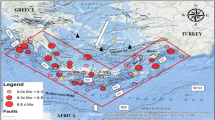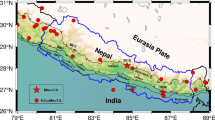Abstract
The use of probability distribution ofrecurrence times as described by theexponential, Weibull and Rayleihgprobability densities form the core of theprobabilistic seismic prediction analysispresented in this paper. Using these threeprobabilistic models we derive threeformulas to calculate the conditionalprobability P(Δt|t) than an earthquakeevent will occur in the time interval (t, t+ Δt), provide that it has not occurredin the elapsed time t since the last largeearthquake (M ≥ 6.4) in the Tokyo area.This paper proposes a new method toestimate the time interval Δt foroccurrence of a new large earthquake inTokyo area. This time interval is measuredafter the elapsed time (t) since the lastlarge earthquake. To do this we use thethree formulas for the conditionalprobability P(Δt|t) and the criterionof the maximum conditional probability ofearthquake occurrence.Using a list of historical earthquakeswhich have occurred in the Tokyo area asgiven by Usami (1976, pp. 235–243), wefound that: (1) Using the exponentialmodel, it is estimated that a highlydamaging earthquake magnitude M ≥ 6.4, mayoccur before the year 2009.50, orequivalently before June 2009; (2) Usingthe Weibull model, it is estimated that thedamaging earthquake (M ≥ 6.4) may occurbefore the year 2129.80, or equivalentlybefore October 2129.
Similar content being viewed by others
References
Benjamin, J.R. and Cornell, C.A., 1970, Probability, Statistic, and Decision for Civil Engineers, Mac Graw-Hill.
Cooper, G.R. and McGillen, C.D., 1971, Probabilistic Methods for Signal and System Analysis, Holt, Rinehart and Winston, Inc.
Cornell, C.A. and Winterstein, S.R., 1998, Temporal and magnitude dependence in earthquake recurrence models, Bull. Seism. Soc. America 78, 1522–1537.
Hagiwara, Y., 1983, A probabilistic process of earthquake occurrences in Tokyo and its adjacent areas, Eart. Pred. Res. 2, 97.104.
Kagan, Y.Y., 1997, Statistical aspects of Parkfield earthquake sequences and Parkfiel prediction experiment, Tectonophysics 270, 270–219.
Kotz, S. and Johnson, N.L., 1988, Encyclopedia of Statistical Wiley, New York, Vol. 9.
Matsuda, T., Ota, Y., Ando, M. and Yonekura, N., 1978, Faulty mechanism and recurrence time of major earthquakes in southern Kanto district, Japan, as deduced from coastal terrace data, Geol. Soc, Am. Bull. 89, 1610–1618.
Matuzawa, T., 1964, Study of Earthquakes, UNO SHOTEN, Tokyo, Japan.
Mogi, K., 1985, Earthquake Prediction, Academic Press, Japan Inc.
Meyer, P.L., 1972, Introductory Probability and Statistical Applications, Addison Wesley Publishing Company.
Rhoades, D.A. and Evison, F.E., 1989, Time-variable factors in earthquake hazard, Technophysics 167, 201–210.
Rikitake, T., 1990, Threat of an earthquake right under the capital in Japan, Earthqs. & Volc. 22, 209–210.
Rikitake, T., 1991, Assessment of earthquake hazard in the Tokyo area, Tecnophysics 199, 121–131.
Sieh, K., Stuiver, M. and Brillinger, D., 1989, A more prices chronology of earthquakes produced by the San Andres Fault in southern California, J. Geophys. Res. 94, 603–623.
Sornette, D. and Knopoff, L., 1997, The paradox of the expected time until the next earthquake, Bull. Seism. Soc. Am 87(4), 789–798.
Usami, T. and Hisamoto, S., 1970, Probability of a future earthquake with high intensity in the Tokyo area, Bull. Eartq. Res. Inst. Tokyo Univ. 48, 331.
Usami, T., 1976, History of disastrous earthquakes in Edo (Tokyo), Bull. Earthq. Res. Inst., Tokyo Univ. 51, 231–250.
Utsu, T., 1984, Estimation of parameters for recurrence models of earthquakes, Bull. Earthq. Res. Inst., Univ Tokyo 59, 53–56.
Utsu, T., 1988, A catalog of large earthquakes (M≥6) and damaging earthquakes in Japan for the years 1985–1925, In: Lee, W.H.K., Meyers, H. and Shimizaki, K. (eds.), Historical Seismograms and Earthquakes of the World, Acamic Press San Diego, pp. 150–161.
Watanabe, S., 1936, Contingency, Persistence and Periodicity of Earthquake Occurrence, Riken – Iho.
Wesnousky, S.G., Scholz, C.H., Shimizaki, K. and Matsuda, T., 1984, Integration of geological and seismological data for the analysis of seismic hazard: A case study of Japan, Bull. Seism. Soc. Am. 74(2), 687–708.
Winkler, R.I. and Hays, W.L., 1975, Statistic: Probability, Inference, and Decision, Holt, Rinehart and Winsten.
Author information
Authors and Affiliations
Rights and permissions
About this article
Cite this article
Ferraes, S.G. The conditional probability of earthquake occurrence and the next large earthquake in Tokyo, Japan. Journal of Seismology 7, 145–153 (2003). https://doi.org/10.1023/A:1023506931939
Issue Date:
DOI: https://doi.org/10.1023/A:1023506931939




